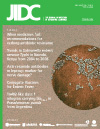Trends in Salmonella enteric serovar Typhi in Nairobi, Kenya from 2004 to 2006
DOI:
https://doi.org/10.3855/jidc.503Keywords:
Quinolone, Multidrug Resistance, Disk diffusion, Minimum Inhibitory Concentration (MIC)Abstract
Background: Typhoid fever is a global health problem. The World Health Organization (WHO) estimates that the current annual global burden of typhoid is approximately 22 million new cases, 5% of which are fatal.
Methodology: To assess the trends in antibiotic resistance in 100 Salmonella enterica serovar Typhi strains were isolated from the blood of patients in Nairobi, Kenya, from 2004 to 2006. All isolates were tested against ampicilin, chloramphenic, nalidixic acid, ciprofloxacin, cotrimoxazole, cefuroxime, cefriaxone, amoxycillin/clavulanic acid, tetracycline and gentamycin. Susceptibility and resistance were determined using MIC and disk diffusion tests.
Results: From 2004 to 2006 a total of 100 strains were studied; 70% of the isolates were multidrug resistant (MDR) while 15% of the isolates were sensitive to all drugs tested. Of 13 isolates that were resistant to ciprofloxacin and nalidixic acid by disk diffusion, 11 had an MIC of 0. 25 µg/ml while two isolates had an MIC of 1.00 µg,/ml. Resistance in ampicillin decreased from 88% in 2004 to 64% in 2005; this increased to 76% in 2006. Similar trends were observed for four other antibiotics tested.
Conclusion: The prescription of first-line antibiotics used in the treatment of S. Typhi should be stopped temporarily. Drugs such as cipfloxacin would be useful in the treatment of typhoid caused by MDR S. Typhi. There is need to monitor the resistance in flouroquinolones as resistance to these drugs has been observed and they are the current drugs used to treat typhoid.
Downloads
Published
How to Cite
Issue
Section
License
Authors who publish with this journal agree to the following terms:
- Authors retain copyright and grant the journal right of first publication with the work simultaneously licensed under a Creative Commons Attribution License that allows others to share the work with an acknowledgement of the work's authorship and initial publication in this journal.
- Authors are able to enter into separate, additional contractual arrangements for the non-exclusive distribution of the journal's published version of the work (e.g., post it to an institutional repository or publish it in a book), with an acknowledgement of its initial publication in this journal.
- Authors are permitted and encouraged to post their work online (e.g., in institutional repositories or on their website) prior to and during the submission process, as it can lead to productive exchanges, as well as earlier and greater citation of published work (See The Effect of Open Access).








